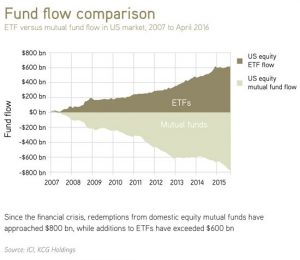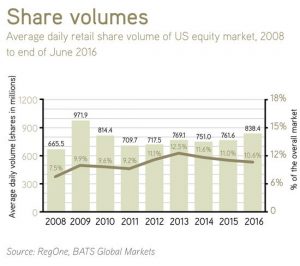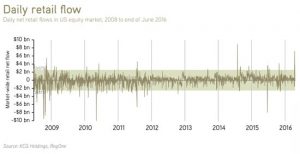PHIL MACKINTOSH and JONATHAN MAIRS, IR MAGAZINE
Amid the continuing shift in assets to quant funds and passive ETFs, retail investors are a worthwhile target.
| Oct 6, 2016
At a glance Steady players Understanding retail investors Targeting tips |
Long an afterthought in terms of IR planning and outreach, the retail investor may prove in the end to be one of the few non-programmable, stock- selecting segments left in the market.
The shift from active to passive management is well documented. Assets are slowly migrating from traditional mutual funds to exchange-traded funds (ETFs) and indexes over issues of performance and fees (see Fund flow comparison, below). Although the first ETFs debuted more than 25 years ago, the category remains unabashedly in growth mode. The 2009 acquisition of iShares by BlackRock for $US13.5 bn stands as a defining moment for proponents of passive investing.
Less remarked upon is the movement within active management from traditional fundamental managers to quantitative managers that use mathematical models to generate investment returns. Although quantitative analysis is a core part of the stock selection process for all active managers, just about every one of the largest mutual fund companies by assets under management now offers purely quantitative funds. Of the top 15 hedge funds by assets under management, five are entirely or predominantly quantitative in nature.
And it isn’t just portfolio buy/sell decisions that are on auto-drive; it’s also trading in the US equity market as a whole. Intraday price movements are far less an indicator of investor sentiment than commonly held. According to data from ModernIR, just 12 percent to 15 percent of daily trade volume in an average stock is attributable to active management based on a rational assessment of company fundamentals. The sizable remainder is driven by speculation, program trading, hedging and market making.
Feeling apprehensive at the proliferation of robotic portfolio management? Don’t be. According to data from the Federal Reserve, direct ownership of stocks by US citizens comprises more assets than all mutual funds combined. Yes, you read that correctly. The reality of the retail investor is quite different from the stubborn caricature as insignificant, unsophisticated and inattentive, consistently mistiming the market cycle to buy high and sell low.
A leading market maker, KCG Holdings handles more than one in every four shares traded by retail investors. Its clients comprise hundreds of discount online brokers, wire houses, banks, private wealth managers, registered investment advisers, certified financial planners and suchlike with a fiduciary duty to retail investors. Market makers compete for order flow from clients primarily on execution metrics set by the SEC. In the past 20 years of handling retail orders, KCG has come to appreciate the resilience and consistency of this segment of investors.
Sophisticated shareholders
Retail investors as a composite are generally well educated, wealthy and professionally advised. During the first half of 2016, retail order flow accounted for just over 10 percent of all US equity share volume with activity concentrated in the information technology, consumer discretionary and industrials sectors. Retail investors have a demonstrated preference for investing in emerging growth companies, and they are tax-sensitive, with capital gains and losses driving heightened trading activity at year-end.
Retail investors on the whole don’t chase market rallies and aren’t fazed by turbulence, either; an analysis of net retail flows shows no correlation to either market returns or market volatility. What’s more, since the financial crisis of 2008 just three market events led to retail outflows of $8bn or more: the Lehman Brothers bankruptcy in September 2008, the Flash Crash in May 2010 and the China stock market sell-off in August 2015 (see Daily retail flow, below). Reinvestment following sell-offs is typically fast, resulting in just brief periods of decreased ownership of stocks.
Correcting misperceptions of the retail investor is a necessary step in course correction. In a 2014 NIRI survey, just 23 percent of respondents report that they actively seek to attract retail investors. Of course, the reasons behind such a low response rate are considerably more complicated than a simple misreading of the facts.
For the IRO, the difficulties associated with programing for retail investors are well known. Attention is appropriately placed on larger institutions with defined investing styles that can immediately affect the stockholder base and market valuation. Resources for most IR departments are already stretched, and the time required for outreach to advisers and brokers – not to mention tracking its effectiveness – can be onerous. Growth in the percentage of retail in the stockholder base is usually piecemeal .
From there, proceed to an assessment of channels. Don’t accept that widening outreach will require a significantly heavier footprint. Use social media to link to developments at the company as well as news within the industry and broader economy that support the thesis. Expand the use of webcasting – specifically video – to produce brief segments spotlighting financial guidance, competitive updates, capital return, and so on, and push out links to email alerts subscribers. Experiment with broker outreach in a targeted manner, both in person and through conference calls, with the proper surveillance mechanisms in place to capture the resulting activity.
As with any new effort, accept that you are engaged in a learning process. Regular reviews of tactics and results will inevitably yield failures, but they are critical. Landing on a particular methodology to achieve repeatable results can potentially boost your company’s market valuation as well as provide added price stability.
| Target practice
All that being said, a good portion of IR professionals appear to be potentially missing an opportunity. Might that apply to you? To find out, the simplest place to start is with a self-assessment of the content of your communications: – How accessible is your investment rationale to a non-professional audience? – Do your disclosed financial and non-financial metrics tie easily to the growth strategy? – Is sector-specific knowledge required to understand the terms discussed in your press releases, conference calls and investor presentations? |
Phil Mackintosh is head of trading strategy and analysis and Jonathan Mairs is head of IR for KCG Holdings in New Jersey
This article appeared in the fall 2016 issue of IR Magazine
Reproduced with permission


